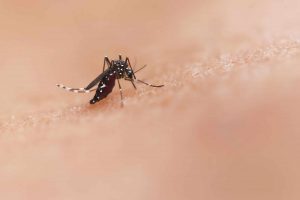Eastern Equine Encephalitis (EEE) Fact Sheet
Authors: Arashi Nakashima and Emily Reinhardt
Arashi.nakashima@uconn.edu
Reviewers: Paulo Verardi and Elsio Wunder
Publication: September 2024 | EXT081
https://doi.org/10.61899/ucext.v1.081.2024
Introduction
Eastern Equine Encephalitis (EEE) is a severe viral disease caused by the Eastern Equine Encephalitis virus (EEEV). The virus mainly circulates among birds, through mosquito bites, and can infect other animals, as well as humans. EEE is found primarily in the Eastern U.S., Great Lakes region, and along

the Gulf Coast.
Eastern Equine Encephalitis is spread through the bite of an infected mosquito that acquire the virus from birds. Mosquitos can then transmit the virus to humans and animals. Key mosquito species involved include Culiseta melanura, which feeds mainly on birds, and Aedes and Coquillettidia, which are known to bite both birds and mammals, including humans and horses.
Humans and horses do not spread the virus further.
Eastern Equine Encephalitis has been detected in Connecticut. The state experiences occasional outbreaks, particularly in wetland areas. The Connecticut Veterinary Medical Diagnostic Laboratory (CVMDL) plays a key role in diagnosing EEE. In 2023 and 2024, cases were found in horses, emu, ring-necked pheasant, common raven, wild turkey, barred owl, and a white-tailed deer.
Health Effects in Humans
Systemic Illness expresses with fever, chills, muscle pain, and headaches. These symptoms are usually mild, and resolve in one to two weeks.
Encephalitic Illness includes severe brain inflammation, which causes symptoms such as fever, headache, confusion, and seizures. It can be fatal; survivors may have long-term neurological issues. If experiencing these symptoms and living in areas of high risk, seek medical attention and alert physicians and medical staff of residing in an area known to have virus-carrying mosquitos.
EEE Treatment
While there is no specific antiviral treatment for EEE, treatment focuses on supportive care, including:
- For people: Hospitalization with respiratory support, IV fluids, and medications for pain and seizures.
- For horses: Supportive care includes hospitalization, anti-inflammatory medications, IV fluids, and nutritional support.
Protection Guidelines for Humans and Animals
- Avoid being outdoors when mosquitoes are most active (primarily at dusk and dawn);
- When outdoors, use mosquito repellents with EPA-registered active ingredients, including DEET, Picaridin, IR3535, oil of lemon, eucalyptus, para-menthane-diol (PMD), or 2-undecanone. These are all proven safe and effective for use on skin. Please note some of these are toxic to pets; only use veterinarian recommended pet-safe products;
- Consider wearing clothing treated with permethrin which will repel mosquitoes and ticks;
- When outdoors, protect skin from mosquito bites by wearing shoes, socks, long pants, and a long-sleeved shirt. Wear light-colored and loose-fitting clothing made from tightly woven material to keep mosquitos away from skin;
- Make sure there is no standing water near the home, such as in empty planters, or bird baths;
- Make sure window screens are tight-fitting and in good repair;
- Use mosquito netting when sleeping outdoors, and treat camping gear with permethrin;
- Use mosquito netting to cover strollers and baby carriers when outdoors;
- Horse owners are urged to seek veterinary care, and keep horses up to date on biannual vaccinations for EEE and West Nile Virus.
Additional Resources
Agnew, D. (2018). Camelidae. In K. A. Terio, D. McAloose, & J. St. Leger (Eds.), Pathology of Wildlife and Zoo Animals (pp. 196–197). Academic Press.
Andrews, C., Gerdin, J., Patterson, J., Buckles, E. L., & Fitzgerald, S. D. (2018). Eastern equine encephalitis in puppies in Michigan and New York states. Journal of Veterinary
Diagnostic Investigation, 30(4), 633–636. https://doi.org/10.1177/1040638718775796
Miller, A. D., & Porter, B. F. (2022). Nervous system. In J. F. Zachary (Ed.), Pathologic Basis of Veterinary Disease (7th ed., pp. 960–961). Elsevier.
Schmidt, R., Reavill, D. R., & Phalen, D. N. (2015). Pathology of Pet and Aviary Birds (2nd ed.). John Wiley & Sons.
Summers, B. A., Cummings, J. F., & de Lahunta, A. (1995). Veterinary Neuropathology. Mosby.
Online Information
The information in this document is for educational purposes only. The recommendations contained are based on the best available knowledge at the time of publication. Any reference to commercial products, trade or brand names is for information only, and no endorsement or approval is intended. UConn Extension does not guarantee or warrant the standard of any product referenced or imply approval of the product to the exclusion of others which also may be available. The University of Connecticut, UConn Extension, College of Agriculture, Health and Natural Resources is an equal opportunity program provider and employer